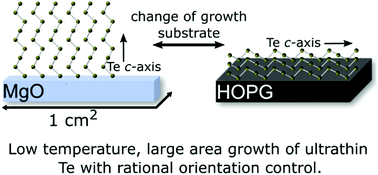Large-area ultrathin Te films with substrate-tunable orientation†
Abstract
Anisotropy in a crystal structure can lead to large orientation-dependent variations of mechanical, optical, and electronic properties. Material orientation control can thus provide a handle to manipulate properties. Here, a novel sputtering approach for 2D materials enables growth of ultrathin (2.5–10 nm) tellurium films with rational control of the crystalline orientation templated by the substrate. The anisotropic Te 〈0001〉 helical chains align in the plane of the substrate on highly oriented pyrolytic graphite (HOPG) and orthogonally to MgO(100) substrates, as shown by polarized Raman spectroscopy and high-resolution electron microscopy. Furthermore, the films are shown to grow in a textured fashion on HOPG, in contrast with previous reports. These ultrathin Te films cover exceptionally large areas (>1 cm2) and are grown at low temperature (25 °C) affording the ability to accommodate a variety of substrates including flexible electronics. They are robust toward oxidation over a period of days and exhibit the non-centrosymmetric P3121 Te structure. Raman signals are acutely dependent on film thickness, suggesting that optical anisotropy persists and is even enhanced at the ultrathin limit. Hall effect measurements indicate orientation-dependent carrier mobility up to 19 cm2 V−1 s−1. These large-area, ultrathin Te films grown by a truly scalable, physical vapor deposition technique with rational control of orientation/thickness open avenues for controlled orientation-dependent properties in semiconducting thin films for applications in electronic and optoelectronic devices.



 Please wait while we load your content...
Please wait while we load your content...